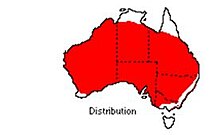Enchylaena tomentosa
| Enchylaena tomentosa | |
|---|---|
 |
|
|
Not evaluated (IUCN 3.1)
|
|
| Scientific classification | |
| Kingdom: | Plantae |
| (unranked): | Angiosperms |
| (unranked): | Eudicots |
| (unranked): | Core eudicots |
| Order: | Caryophyllales |
| Family: | Amaranthaceae |
| Genus: | Enchylaena |
| Species: | E. tomentosa |
| Binomial name | |
|
Enchylaena tomentosa R.Br. |
|
| Varieties | |
 |
|
| Distribution of ruby saltbush | |
E. tomentosa var. tomentosa
E. tomentosa var. glabra
Enchylaena tomentosa, commonly known as barrier saltbush or ruby saltbush, is a small native shrub of Australia.
Enchylaena tomentosa grows as a small perennial shrub, up to a meter in diameter. Leaves are slender and cylindrical growing to 6-15mm long, both leaves and stems are densely covered in woolly hairs. Fruits form as fleshy berries changing from bright green/yellow to bright red/orange.
The derivation of the name helps describe and classify its features with Enchylaena coming from the Greek egchlos meaning fleshy or succulent and chlaen a cloak referring to the ripe fruiting perianth, tomentosa botanical Latin outlining that the plant is covered with dense short or curled hairs soft hair.
Highly drought tolerant E. tomentosa has historically been sought after by Indigenous Australians, early settlers and livestock. Nutritional analyze gives the plant a 65% digestibility rating providing grazing species with 14% digestible protein and 6% digestible salt.
It was first published by Robert Brown in 1810, as the only species of Enchylaena. Since that time a number of putative new species have been published based on specimens that are now referred to this species; hence it has a number of taxonomic synonyms. Two varieties are recognised: the autonym E. tomentosa var. tomentosa, and a less woolly variety, E. tomentosa var. glabra, which was published by George Bentham in 1870. Its previous family name Chenopodiaceae is now included in Amaranthaceae.
It occurs throughout Australia, and has also naturalised in New Caledonia. It tolerates a range of soils, but prefers soils that are slightly saline. Occurring through most of semi-arid Australia, on a variety of land and soil types such as sand plains, hill slopes, creek lines, sand dunes and salt lake shores. Preferring slightly shaded soil areas under trees such as Alectryon oleifolius and Acacia papyrocarpa.
...
Wikipedia
